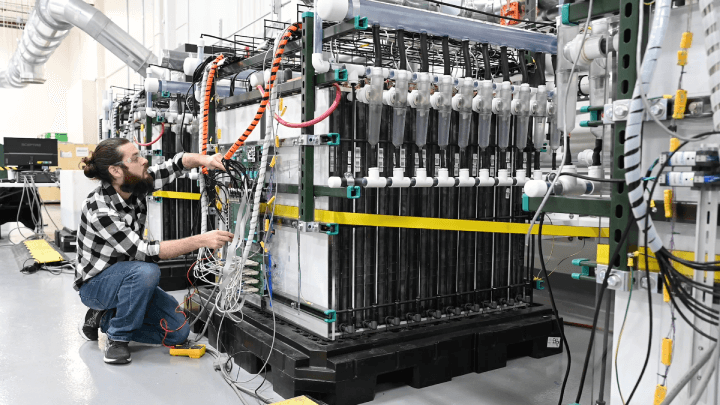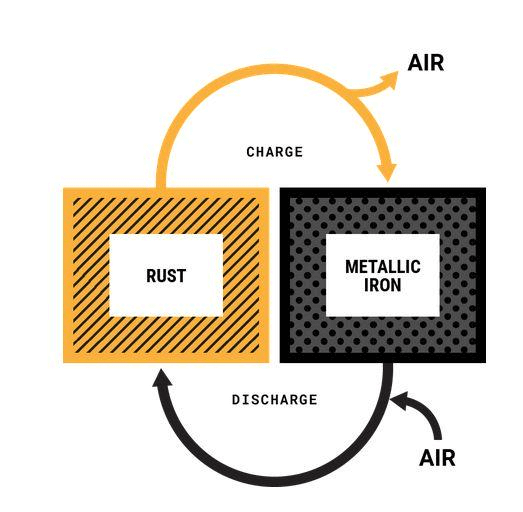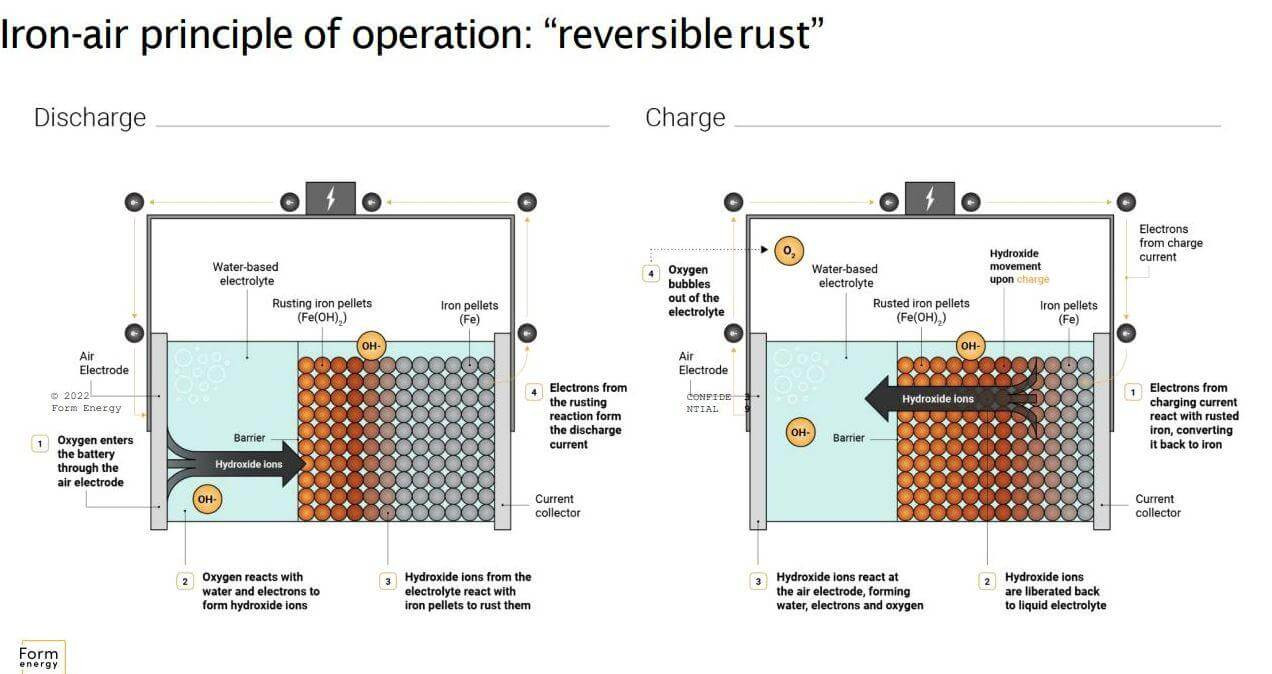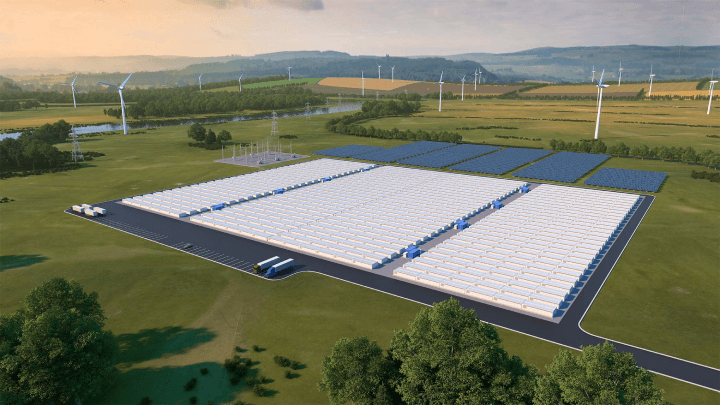How Rust Air Batteries Are Transforming Green Energy Storage
Insights | 19-09-2023 | By Gary Elinoff
It’s now possible to garner vast amounts of electricity from wind and solar power. However, the challenge lies in finding effective renewable energy solutions for storage. As described in a PBS NOVA1 article, Form Energy’s Yet-Ming Chang explains that electricity is basically just electrons flowing between atoms - “the ultimate perishable commodity” because if you don’t use it or store it, it’s lost.
Through analysis of weather patterns and other metrics, Form Energy has zeroed in on the need for 100 hours of efficient storage, showcasing the potential of long-duration battery technology.

An Electrical Engineer works on a Form Energy Battery Module. Image source: PBS
The Quest for Efficient Energy Storage: Iron-Air Batteries Take Centre Stage
As highlighted in the PBS article, iron-air batteries are emerging as a promising solution to the energy storage challenge. These batteries offer a sustainable energy storage solution, using iron and air to store and release energy, offering a more sustainable and cost-effective alternative to traditional lithium-ion batteries.
Iron-air batteries use a combination of iron, air, and a liquid electrolyte to generate electricity. The technology has been around for decades. However, it has been overshadowed by lithium-ion batteries. While they are more compact and have a higher energy density, they are also more expensive and have a shorter lifespan.
The present best candidate for storing energy for those times when the sun doesn’t shine and the wind doesn’t blow is the Lithium Ion Battery (LiB). However, the industry is looking beyond lithium-ion technology to address its limitations. Practical LiB solutions can store energy for only a few hours, but after that time has passed, utilities have no choice but to revert to peaker plants that rely on hydrocarbons.
According to Chang, “In order to do multi-day storage, we have to have batteries that cost about one-tenth or less than today’s lithium-ion battery packs.” And, as we’ll see, the cost isn’t the only thing wrong with using LiB’s for utility-scale electrical storage. This highlights the need for cost-effective energy storage solutions like iron-air batteries.
Rust air batteries, aka iron air batteries, are one of the latest green energy innovations based on the principle of reversible rusting, and they can extend that time limit to 100 hours at a lower cost and with improved safety.
The Science Behind Rust Air Batteries
A not very well-known fact is that the formation of rust is an exothermic reaction; that is, a reaction that produces energy.

The basic idea behind Rust Air Batteries. Image source: Form Energy
The basic principle behind Rust-Air Batteries is reversible rusting. As illustrated above, when charging the system, the application of electrical energy converts rust (Fe2O3) into Iron (Fe) and Oxygen (O2). When discharging or supplying energy, the process is reversed, with Oxygen combined with Iron to produce rust.
Form Energy's innovative approach to battery technology is leading a revolution in renewable energy storage. Their iron-air batteries are designed to provide long-duration energy storage, making them ideal for integrating with renewable energy sources like wind and solar.
"Our iron-air battery technology leverages an abundant and safe resource—iron—to provide long-duration storage at a tenth of the cost of conventional lithium-ion batteries." - Form Energy
A Deep Dive into Iron Air Batteries
The idea of reversing rust is not new, and it’s widely known that under certain circumstances, the application of electricity can reverse rust in structures built of iron. NASA has been experimenting with the concept since the 1960s, but as is so often the case, it took time for practical engineering solutions to catch up with a scientific concept.
The US Department of Energy2, in its recent Energy Storage Grand Challenge Summit, published a report that highlighted Iron-Air batteries, focusing on Form Energy’s work. The operation of their “reversible rust” battery is detailed below.

A Deeper Dive into Rust Iron Batteries: Image source US Department of Energy (Click to enlarge)
The battery is based on an iron electrode and an air electrode. The space between them is filled by a water-based electrolyte, and that space is divided by a membrane that blocks iron but is permeable to OH- ions.
Charging. First, examining the charging cycle on the right, we see rust transformed into iron at the anode; the anode itself is largely composed of iron. Here’s what happens - we first observe the charging current reacting with the rusted iron (FeOH2) on the electrode, converting it back to iron and hydroxide (OH-) ions. The liberated OH- ions, attracted to the other, positively charged air-based cathode electrode, transverse the barrier. It is here that the ions combine with Oxygen in the air, liberating O2 and water.
Discharging. The discharging cycle, where iron is turned into rust, is illustrated on the right. Oxygen from the air electrode (the cathode) reacts with the electrolyte, forming hydroxide ions. The hydroxide crosses the permeable barrier and reacts with the iron to form rust. Finally, this rusting action produces the electrons, thereby producing electricity.
Comparing Iron Air Batteries to Lithium Ion Batteries
The element lithium is available in relatively few places worldwide. Mining is difficult, and the operation presents significant environmental hazards, and the price of lithium reflects these problems. Iron, on the other hand, is the fourth most widely available element in the world and is correspondingly less expensive.
The dangers of LiBs are well known. They are prone to explosion. Additionally, they require exacting, expensive, and difficult electronic control circuitry to ensure safety. Due to their very nature, they leak energy over time – think of a bank account whose balance decreases every day, whether or not money (energy) is withdrawn.
Leaky, expensive and dangerous LiBs are the weak spot of electric vehicles (EVs). However, the electric motors that power EVs, the EV’s recharging brakes and a host of other systems make for a vastly more efficient use of energy than possible with gas-powered vehicles. In addition, they emit no pollutants as they power EVs, eliminating the need for anything like the petroleum-powered vehicle’s catalytic converter. These advantages are so great that they offset the many problems of their power source. However, the low storage capacity and the short duration of LiBs make them an unsatisfying choice for long-term energy storage.
Iron-air batteries will cost only 10% of what LiBs cost on a watt-hour-by-watt-hour basis. They are modular, scalable, and environmentally friendly, showcasing the many iron-air battery advantages. Because they are slower to charge and discharge than LiBs, they are often paired with LiBs on the front end. Most importantly, iron-air batteries cannot explode; they are made from environmentally friendly battery materials and are readily recyclable.
The one possible drawback of iron-air batteries is their size and weight, as compared to LiBs. But as we’ll see, this is really no disadvantage at all if they are employed in utility-scale storage systems.
Iron Air Batteries in Utility Scale Storage
Under Form Energy’s plan, each battery module will contain 50 battery cells, which will be built together into protected enclosures. Hundreds will be grouped together. Form Energy states that a 3-megawatt installation will take up about one acre of ground space.

An Iron-Air Battery Installation. Image source: Form Energy
Note the solar farm to the top right of the battery installation, and also notice the rural location. As reported in the Associated Press4, the SunZia transmission line will stretch a full 550 miles, and it will carry a staggering 3500 megawatts of power from sparsely populated rural New Mexico to California and to power-hungry portions of Arizona. The Biden administration has set a goal to eliminate carbon emissions from the power sector by 2035. The effort faces numerous challenges, including the lack of transmission.
The size of the battery system doesn’t really matter, and here's why: modern electrical power transmission systems are surprisingly efficient. As a result, neither the battery nor the renewable energy sources need to be close to the urban or industrial centres where the power is used. This allows developers to save vast amounts of money by building where land is cheap.
Renewable energy Cannot Flourish without Energy Storage
We recently reported on The Economics of Green Energy: A Case Study of Wind Ranchers in Texas. To all appearances, the Texans did everything right, including the construction of a robust system of power lines. But then something happened - the sky was cloudy, AND the wind didn’t blow. Officials were forced to go to their peaker plants for an extended period of time.
Unlike wind and the sun, hydrocarbons come with a cost. Additionally, they generate various environmental hazards, including carbon dioxide. This is why if renewable energy is to flourish, so must reliable methodologies for energy storage, like iron-air batteries.
Wrapping Up: Iron-Air Batteries' Bright Horizon
So, where does all this leave us? Simple. As the renewable energy sector surges ahead, there's a clear need for efficient energy storage. Enter iron-air batteries. As PBS and Form Energy have pointed out, these aren't just any batteries. They're cost-effective, long-lasting, and, let's face it, a lot safer than their lithium-ion counterparts.
Form Energy's work is particularly noteworthy here. They're not just talking about the potential; they're actively shaping the future of energy storage. And with the US Department of Energy also in the mix, it's evident that iron-air batteries are more than just a passing trend.
In a nutshell? As we navigate the challenges of renewable energy, iron-air batteries are emerging as a beacon of hope. They're not just a solution; they're the solution we've been waiting for.
References:
1. How iron-air batteries could fill gaps in renewable energy - PBS
2. Battery Technology – Form Energy
3. Energy Storage Grand Challenge Summit - US Department of Energy
4. Powered by wind, this $10B transmission line will carry more energy than the Hoover Dam – Associated Press
Glossary:
Exothermic: A chemical reaction that releases energy.
Peaker Plants: Peaking power plants are generators, generally powered by hydrocarbons, that come online during a period when renewables can supply all the power needed by a utility.
Reversible Rusting: Allowing iron to rust to produce energy and reversing the rusting to store energy.

